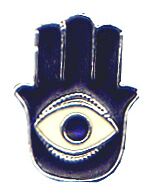Khamsa

The Khamsa (Template:Lang-ar, literally "five", Template:Lang-he). An alternative Islamic name for this charm is the Hand of Fatima or Eye of Fatima, in reference to Fatima Zahra, the daughter of Muhammed. An alternative Jewish name for it is the Hand of Miriam, in reference to the sister of Moses and Aaron as well as the Hamesh Hand. It serves as an ancient talismanic way of averting and getting protection from the evil eye, or more generally of providing a "protecting hand" or "Hand of God". It appears, often in stylised form, as a hand with three fingers raised, and sometimes with two thumbs arranged symmetrically. The symbol is used in amulets, charms, jewelry, door entrances, cars, and other places to ward the evil eye.
Some sources link the significance of the five fingers to the five books of the Torah, the Jewish name for the first five books in the Old Testament scriptures, or to the Five Pillars of Islam, the core principles of Sunni Islamic faith, though this significance may have been attributed after the fact to a symbol that quite possibly pre-dated both religions.
In recent years some activists for Middle East peace have chosen to wear the hamsa as a symbol of the similarities of origins and tradition between the Islamic and Jewish faiths.
Islamic Traditions
Though the symbol holds much significance for many Muslims, particularly in Morocco and Tunisia, around the world it is widely believed to predate Islam. The use of talismans and general superstition is forbidden by the Qur'an. The symbol was previously used in Punic religion, where it was associated with Tanit. Hamsa plaques, usually made of turquoise colored pottery, are readily found in modern Egypt.
Jewish Traditions
Khamsas are popular as charms and decorations in Israel and are not considered to have any Islamic connection other than the Arabic name. They are often made in the form of amulets, wall plaques, keychains, or motifs on other objects, and often feature doves. They are also frequently inscribed with hebrew prayers depending on their use, such as the Sh'ma prayer, the blessing of the house (birkat habayit), or the traveler's prayer (tefilat haderekh).
